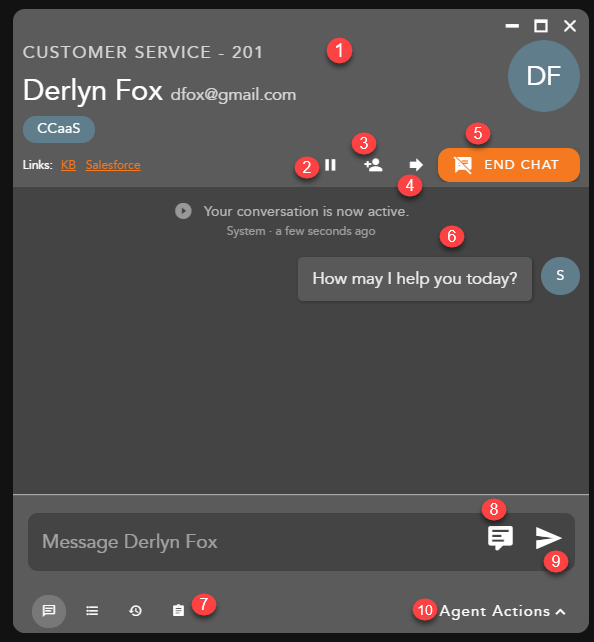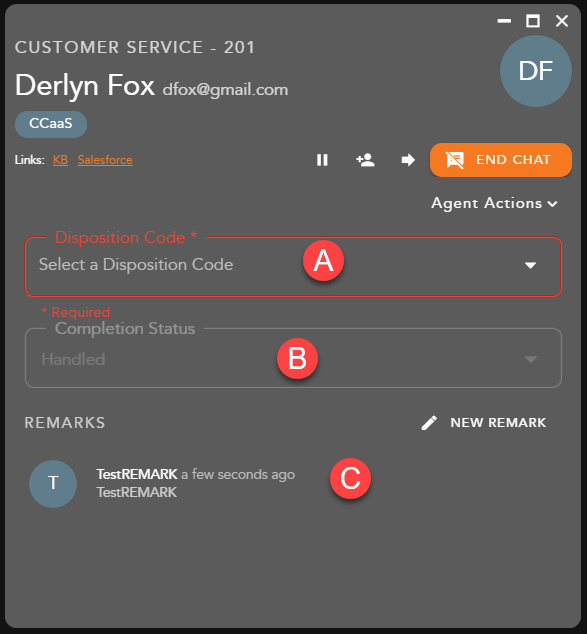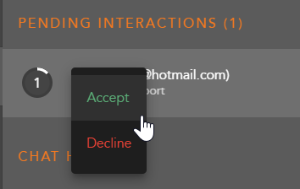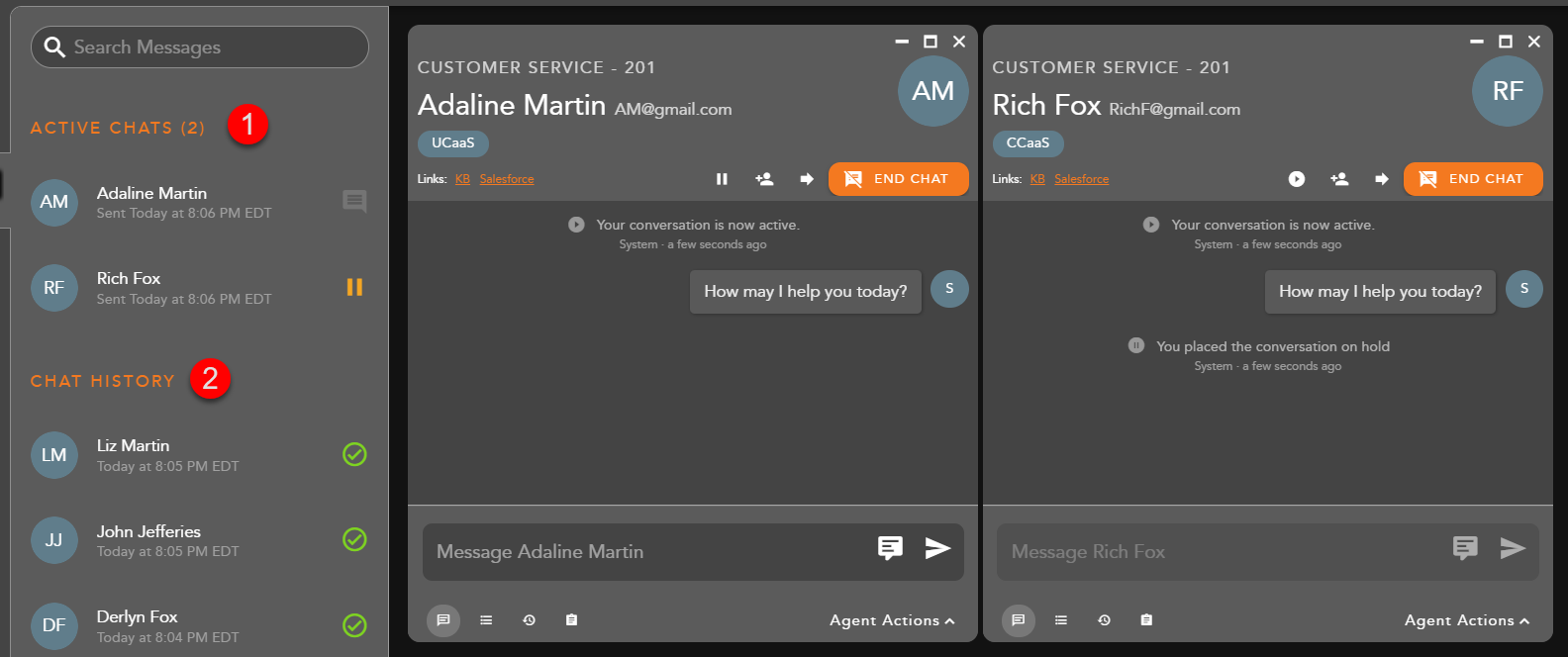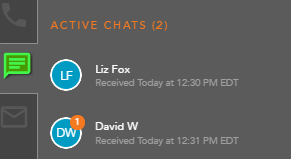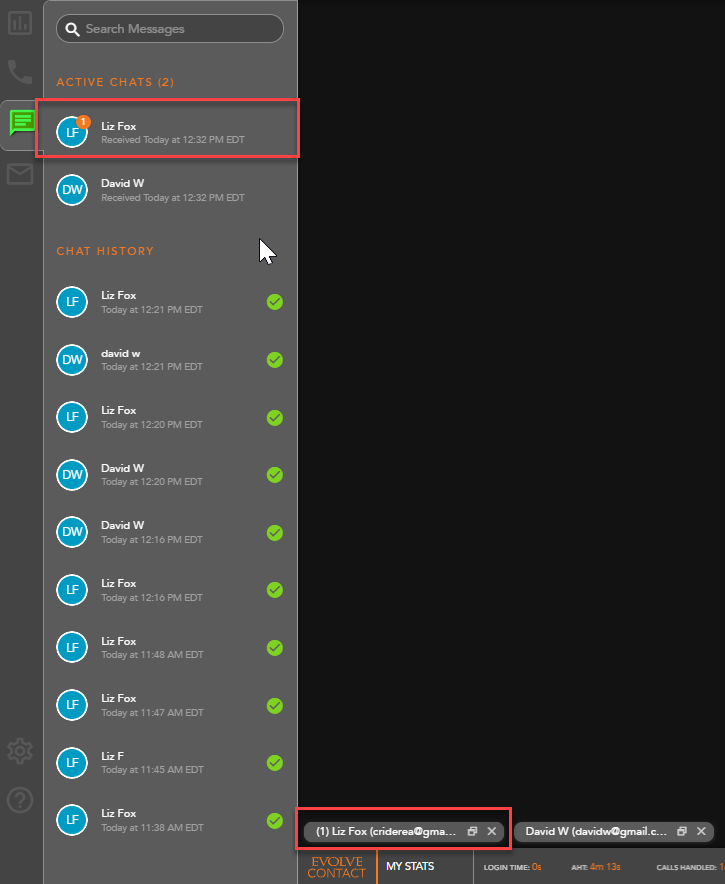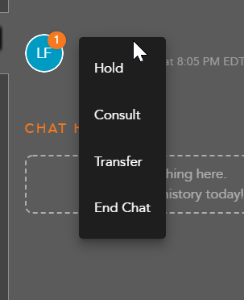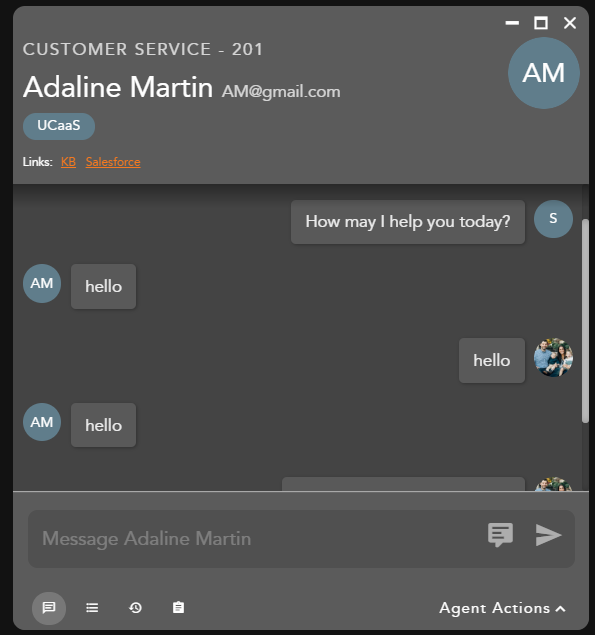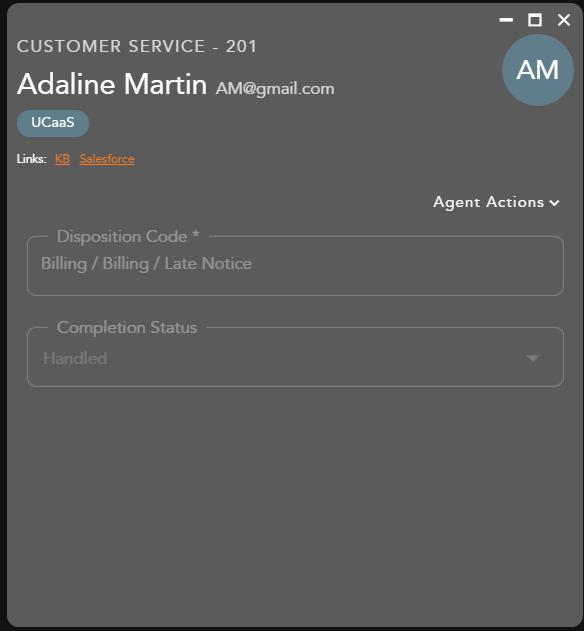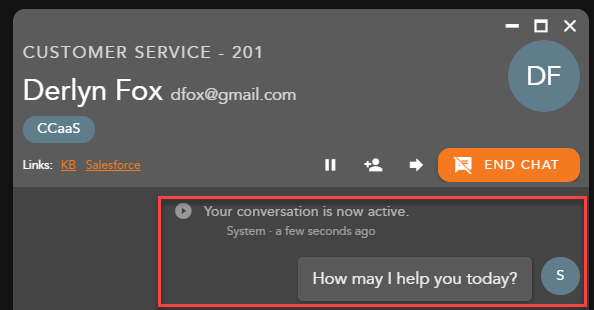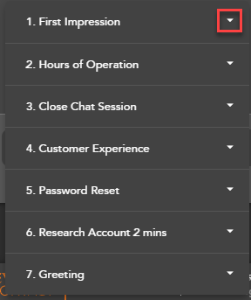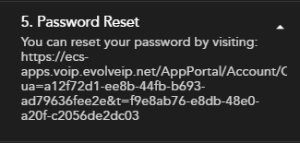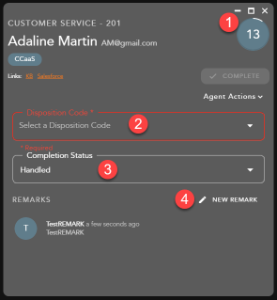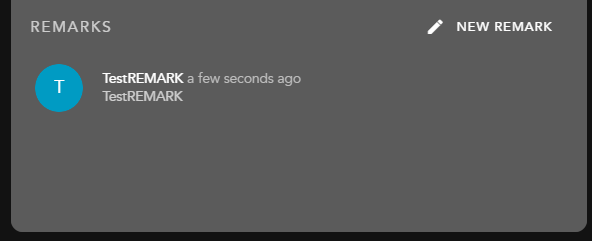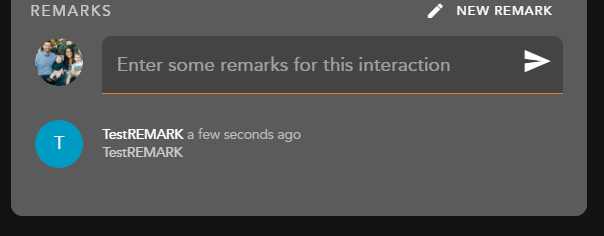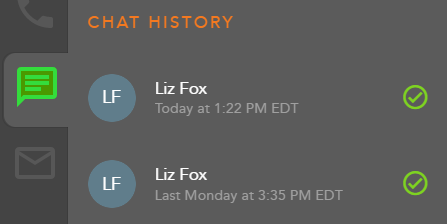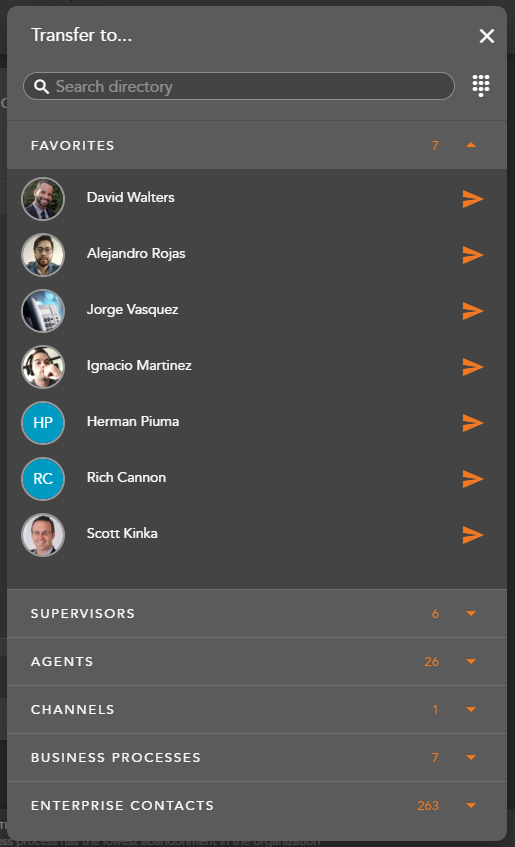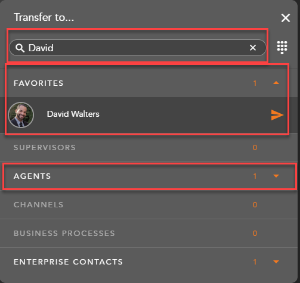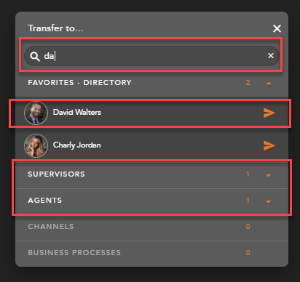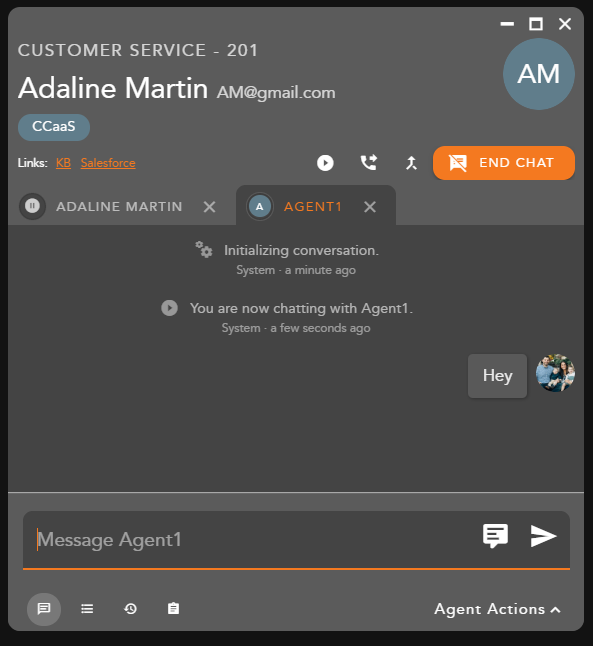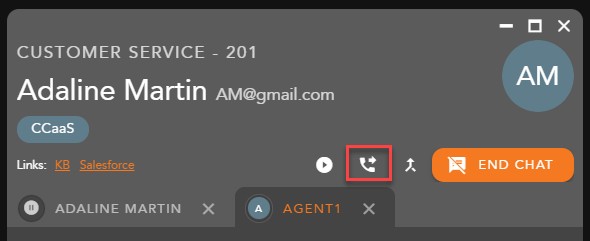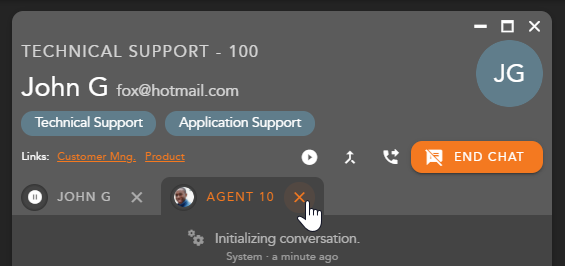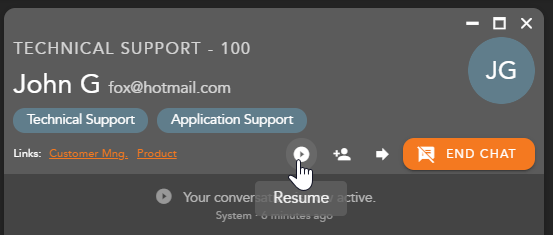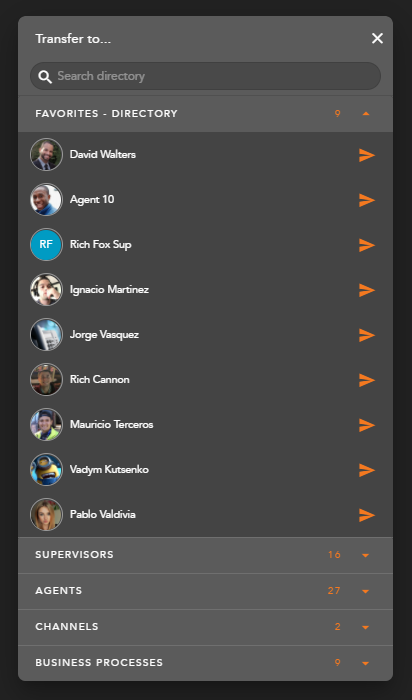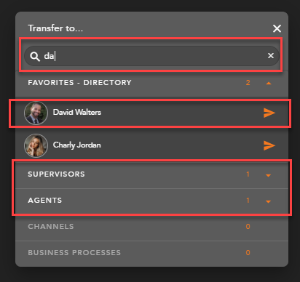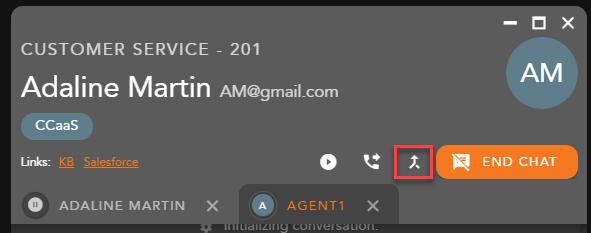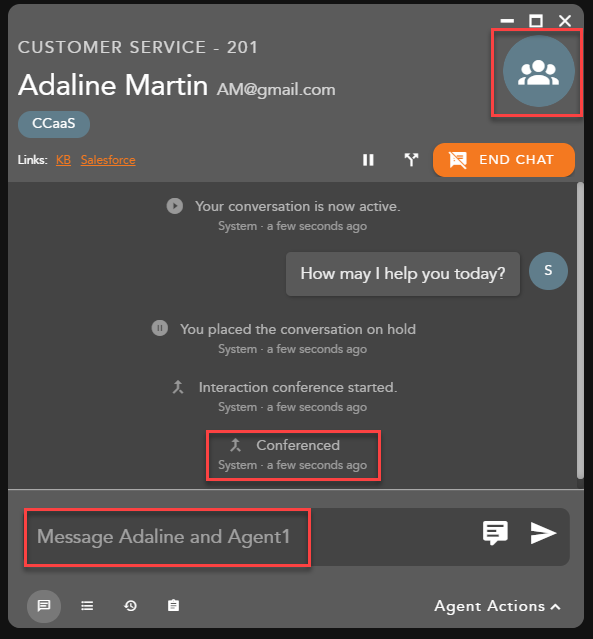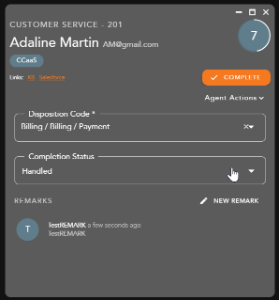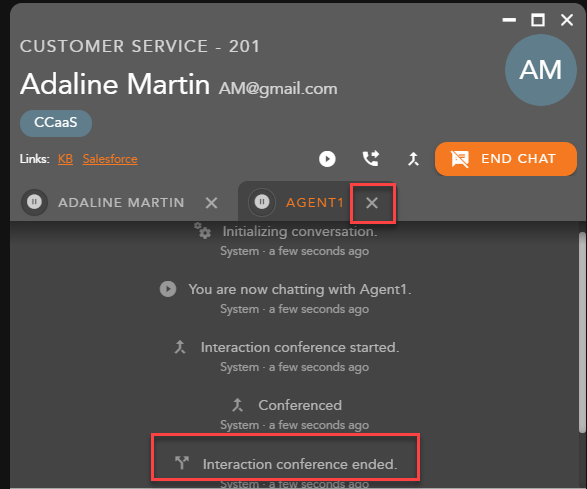Chat Interaction Interface
- Chat Interaction Header - displays the following information:
- Originating Business Process
- Customer Name and Email Address
- Demands
- External Links - hyperlink to open to a URL configured in the Setup client. The links can integrate with a CRM or internal knowledge base, which contains specific information about a customer or help documents. By clicking on a link, you will be redirected to the predefined URL, providing more detailed information on the person they are working with or help documentation.
- Hold - places a chat on hold
- Consult - initiates a consulted transfer with another Agent, Supervisor or BP. Once the transfer has been initiated and accepted, the ability to start a conference will be available.
- Transfer - initiates a blind transfer to another Agent, Supervisor or BP.
- End Chat - ends the chat
- Chat Session
- Interaction Footer - contains the CRM information for the contact - Contacts, History and Notes/Remarks.
- Canned Responses - pre-configured chat responses
- Message Window - type and send replies back to customers
- Agent Actions - selecting agent actions will change the chat screen to show the following options:
- Disposition Code - pre-defined code to indicate the outcome of the interaction. These codes are specific to the Business Process and can be customized for each Business Process.
- Completion Status - explanation as to why the interaction ended. A status may be selected during or after an interaction. The completion statuses available will depend on the type of interaction handled
- Remarks - custom remarks relevant to the interaction and customer. Remarks are saved and available for review on the next interaction the customer has with the contact center and can be found in the CRM panel under Notes and Remarks
Chat Panel
The chat panel displays your:
- Pending Interactions
- Active Chats
- Chat History
Pending Chat Interactions
Within settings, agents can choose how they wish to display their incoming interactions: Banner & Panel, Banner only, or Panel only. If Banner & Panel or Panel is chosen, any incoming pending chat interaction will show up in the Chat panel. It will provide the No Answer Time Out countdown, Interaction Type and Originating BP, Name and Email address. If the agent chooses to only display incoming interactions through the Banner, the interaction panel will not display pending interactions.
From the panel, by right clicking on the pending chat interaction, the agent can accept or decline the interaction:
Active Chats
The Active Chat session displays all active chat interactions. Each active chat will display the name of the contact and the date and time the interaction was received.
When dealing with multiple chat sessions, you will be alerted within the panel when you have received a new message from a contact. The messages will increment each time a new message is received.
If a chat session is minimized, the panel will increment the number of messages received along with providing a visual alert of the waiting interaction to indicate you have new messages waiting.
By right clicking on an active chat within the panel, you will have interaction control to put the chat on Hold, Consult, Transfer or End the chat. For more information on the different interaction controls, see the 'Interacting with a Chat Interaction' section.
Chat History
Chat history will show all recent historical chat interactions, including the customer name and date and time the interaction was handled.
Double clicking on an interaction will open the historical interaction and display the chat history and completion status and disposition code applied to the interaction.
Interacting with a Chat Interaction
Accepting a Chat Interaction
When a new chat interaction is being offered to an agent the following information will be present for review before accepting the interaction:
- The Interaction Type Originating Business Process
- Customer Name and Email Address
- Interaction Handling Remarks - prepopulated through the Interaction Handling Flow configured in the Setup client. If no remarks are present for the interaction this field will not be visible on the interaction.
- Demands - specific demands assigned to the interaction via the handling flow and utilized to assign the interaction to the appropriate agent
- No Answer Time Out - preconfigured in the Setup Client. If the interaction is not answered within this timer, you will be put into a No Answer State.
To accept and reply to the incoming chat, select the icon
To decline the interaction and send the interaction back to queue, select the icon. Note, if you are the only ready agent in the BP, the interaction will continue to present itself until accepted or another agent becomes ready.
Responding to a Chat
Once an interaction has been accepted the system will send an automatic reply to the customer indicating that their chat has been received by an agent.
To send a message, you can:
- Type within the the message window -
- Select the send arrow or enter on your keyboard to send the message
- Utilize a Canned Response -
A list of available response will appear. Select the arrow for a preview of the response.
- Once a response has been selected, it will appear in the message window to allow for edits before sending to the contact. You can add multiple canned responses at one time.
Completing an Interaction
To end a chat interaction, select End Chat . Ending the chat will end the interaction with the customer and automatically put you in a wrap-up state if wrap-up has been pre-configured in the Setup Client. If no wrap-up has been configured, you will automatically be put back into a Ready state.
If Wrap-up has been configured, the following options will be available to complete the interaction:
- Wrap-up Timer - counts down the amount of time left in wrap-up
- Disposition Code - apply a disposition code to the interaction. If no disposition codes have been configured for the originating BP this option will not be available. By default, your three most used disposition codes for the originating BP will be at the top of the disposition drop down, followed by all disposition code categories and subcategories. If the disposition code is mandatory, that option will appear in red. You must select a disposition code before you can complete the interaction
- If the disposition code is mandatory, that option will appear in red. You must select a disposition code before you can complete the interaction
- If the disposition code is mandatory, that option will appear in red. You must select a disposition code before you can complete the interaction
- Completion Status - end result of the interaction. The completion statuses available will depend on the type of interaction handled.
- Handled - default value for completed interactions. The interaction was completed and handled.
- Delegate to Supervisor - this option is only available if enabled for agents in the Setup Client. Once a call has ended, agents can delegate a call to a Supervisor with remarks attached providing an explanation as to why the interaction has been delegated to a supervisor
- Remarks - custom remarks relevant to the interaction and customer. Remarks are saved and available for review on the next interaction the customer has with the contact center and can be found in the CRM panel under Notes and Remarks.
- To add a new remark to the interaction select . Once selected the remarks field will open to add a new remark.
- To add a new remark to the interaction select . Once selected the remarks field will open to add a new remark.
Once you have filled in the required fields select . This will complete the interaction and put you back into a Ready state. If you do not manually select complete and wrap up is configured, the interaction will complete automatically after the wrap-up period has ended. Once an interaction has completed, it will appear under your chat history within the Interaction Panel.
Transferring a Chat
Blind Transfer
To transfer a chat to another Agent, Supervisor, BP or Channel, select the Transfer Icon within the chat window.
The Transfer window will open and by default your favorites will be expanded.
Within the search bar you can type the name of the Agent, BP or Channel you wish to transfer the interaction. As you begin to type, the window will filter each category and make available only the contacts that match your search criteria.
Select the transfer arrow to complete the blind transfer.
Once a contact has been selected, the interaction will disappear and you will receive a successful transfer message
Note* If the contact is in a busy or offline state you will be unable to transfer the interaction. Attempting to transfer to an unavailable contact will result in an error message
Consulted Transfer
To perform a consulted transfer to another Agent, Supervisor, BP or Channel select the Consult Icon within the chat window.
The Transfer window will open and by default your favorites will be expanded.
Within the search bar you can type the name or the User, BP or Channel you wish to transfer the interaction. As you begin to type, the window will filter each category and make available only the contacts that match your search criteria.
Select the transfer arrow to initiate the consulted transfer.
Your chat window will split into two tabs. The first tab is the conversation between you and the customer. The second tab is the initiated consult between you and the Agent, Supervisor, BP or Channel.
The chat window will provide a confirmation message when the consulted contact has accepted your chat.
To complete the consulted transfer select the transfer icon
The interaction window will disappear followed by a transfer success message.
To cancel the consulted transfer select the X in the tab of the consulted party.
This will end the consult and bring you back to the original chat interaction. The message window with be grayed out and you will be unable to type a response until you have selected the resume icon to continue the chat interaction.
Initiating a Conference
To conference in another Agent or Supervisor into the chat select the Consult Icon within the chat window
The contacts window will open and by default your favorites will be expanded.
Within the search bar you can type the name of the Agent, BP or Supervisor you wish to initiate a conference. As you begin to type, the window will filter each category and make available only the contacts that match your search criteria.
*If initiating a Conference with an agent or supervisor they must be in a Ready or Handling Outgoing state. If you attempt to initiate a conference with a Busy agent or supervisor, you will receive an error message.
Select the arrow to initiate the conference.
Your chat window will split into two tabs. The first tab is the conversation between you and the customer. The second tab is the initiated conference between you and the Agent, Supervisor, or BP. The chat window will provide a confirmation message when the contact has accepted your chat.
When you are ready to pull the third party into the chat and begin a conference, select the Conference Icon found in the Interaction Toolbar..
The two tabs will be merged into a single window. The message window will update to say conferenced to indicate a successful 3-way chat conference. The customers avatar will also change to indicate you are currently in a conference.
Ending a Conference
To end the conference and complete the interaction select . The interaction will end and all parties will be disconnected from the interactions. The Agent Actions will open to add a Disposition Code and Remarks, select Complete when ready to complete the interaction.
Split a Conference and Remove Consulted Party
To end a conference and split it back into two separate interactions, select the Split Conference icon
The chat window will split back into two chat tabs and a confirmation message the conference ended will show in the chat window. The first tab is the interaction between the customer and the agent and the second tab is the interaction between the agent and the consulted party. To remove the consulted party and resume the interaction with the customer, select the X icon on the tab.
Once selected the consulted party will be removed and the interaction will revert back to the main interaction window. The contact will be on hold. Resume the interaction, by selecting the Resume icon on the Interaction Toolbar.
